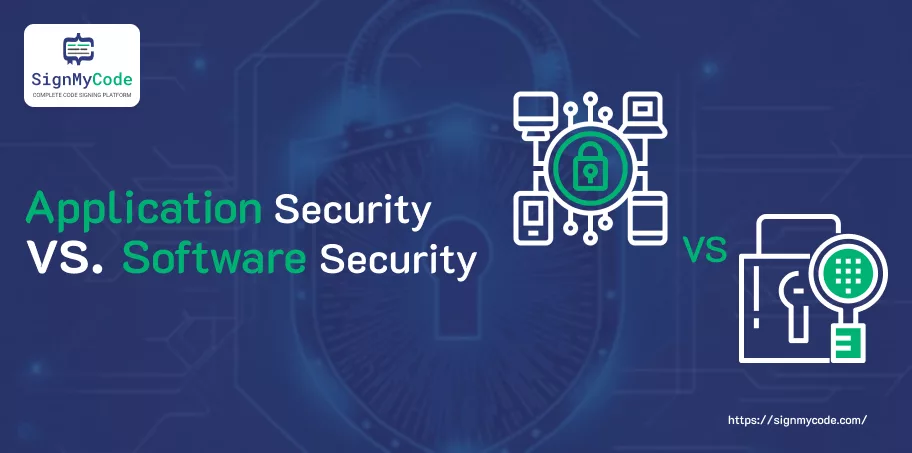Application Security vs. Software Security: Difference to Know

What is Application Security?
The term application security refers to all the practices that are aimed to protect applications from security threats, starting from design and through the development process, up to deployment and maintenance.
Recommended: What is an Application Security? Top 5 App Security Tools
This refers to examining, minimizing, and preventing vulnerabilities that cybercriminals can use to attack the web-based application and disrupt its accessibility, integrity, and confidentiality.
Recommended: Network Security Vs Application Security
This process involves many aspects from secure coding like regular code reviews to carrying out vulnerability assessments, penetration testing, and using tools such as static and dynamic application security testing (SAST and DAST).
Application Security (Post-Deployment) Activities
- Post-deployment security tests
- Capture of flaws in software environment configuration
- The security of the software depends on the code as data (which may include the creation of backdoors and time-bomb-type attacks).
- Patch/Upgrade
- IP Filtering
- Lockdown executables
- During runtime, programs are engaged, and the policy of software use is being enforced.
Recommended: Top Application Security Challenges and Trends
What is Software Security?
Software security is a process of developing programming codes without leaving any holes or gaps which is the ultimate measure for its protection against threats and attacks.
Through application of various security measures at each step of the software lifecycle, secure coding techniques, threat modeling and test rigor, it is achieved.
Authentication and the implementation of systems and strategies for the protection of system and data confidentiality, integrity, and availability is the main objective.
This begins as soon as the software system is provided to the client and this includes the prevention of unapproved access and the protection of the system from any situations which may impair the system and/or the data security.
Software Security (Pre-Deployment) Activities
- Secure software design
- The creation of secure coding guidelines that developers can adhere to will be implemented.
- Developing secure configuration protocols and standards for deployment stage as well
- Processing and displaying of user input and by incorporation of a proper encoding algorithm.
- Secure coding that follows established guidelines
- User authentication
- User session management
- Function level access control
- Use of strong cryptography to secure data at rest and in transit
- Arrest of any flaws in software design/architecture
Recommended: Cyber Security Vs Software Security Vs Application Security
Importance of Software/App Security
Protection of Sensitive Data:
Cyber security is vital as a data security measure, and it protects personal information, financial records, intellectual property, among others, from unauthorized data access, data theft, as well as any modification.
Maintaining User Trust:
Promoting software security is the prerequisite for users to keep their faith and confidence in the operation of the application. Customers have an electronic tendency to use and build a retrospective for software which are known to safeguard and secure data.
Prevention of Financial Loss:
Hackers use security breaches to get access to people’s data, and they can make companies pay huge fees in form of regulatory fines, lawyers and so on, and consequently can damage an organization’s good name. Implementing software security measures acts as a risk mitigation factor and strengthens against legal, financial liabilities.
Compliance with Regulations:
Some industries that have to face the regulations related to data safety are among those that are covered by protective regulations. Software security measures support organizations fulfilling such legislations hence nothing to worry about no penalties and legal consequences.
Protection Against Cyber Threats:
The cyber world is growing steadily, so without knowing it, some nastier cyber threats can not only intrude some unwanted changes in one’s system, but also encrypt the whole system in exchange for monetary compensation.
Preservation of Business Continuity:
Data security mishaps might be a reason to stop operations, resulting in loss of productivity, downtime, and in some cases, a damaged reputation. Sound software security policies safeguard business data from any interruption by avoiding harmful incidents when implemented.
Use Cases
Secure Online Transactions:
E-commerce sites provide software security solutions that protect customers’ credit card data throughout the online transaction process such as storage, transmission and detection of fraud, encryption, secure login and authentication.
Healthcare Data Protection:
Healthcare systems base their software security on the principle that patient health records should be protected as a safeguard against data breaches and to comply with the Health Insurance Portability and Accountability Act (HIPAA), which dictates that patient data needs to be protected from being exposed.
Financial Services Security:
Organizations like commercial banks and financial institutions make use of software security procedures to beef up security measures, protect account details from intruders and safeguard against fraudsters who pose as legitimate customers, but in fact are criminals luring unsuspecting consumers.
Protecting IoT Devices:
Internet of things (IoT) devices, including smart thermostats and security cameras, generally need strong software security to ensure secure access and protect user privacy.
Securing Cloud Computing:
The organizations capitalize on software security to safeguard the data in the cloud and this implies that they secure all the processed data and those that are stored in the cloud by the use of access controls, encryption and network security.
Mobile Application Security:
Mobile apps build the software security that safeguards the data and private info of the users through the use of strong authentication, data encryption and safe coding methods to minimize hacking or malicious actions like insecure data storage and unsecured communication channels.
Critical Infrastructure Protection:
Digital security is the main element for information security of the critical infrastructures, for instance power stations, transport networks, and water treatment facilities, where a hacking could cause a disruption of essential services and operations of them.
Major Difference Between Application Security & Software Security
| Aspect | Application Security | Software Security |
| Definition | Protecting applications from security threats | Ensuring the security of the entire software lifecycle |
| Scope | Focuses on individual applications | Encompasses the entire software ecosystem |
| Primary Focus | Securing application-specific vulnerabilities | Securing software at all stages from development to deployment |
| Approach | Typically reactive, dealing with known vulnerabilities | Proactive and holistic, integrating security throughout the development process |
| Methods and Techniques | Application firewalls, penetration testing, code reviews | Secure coding practices, threat modeling, security training, automated tools |
| Key Objectives | Preventing unauthorized access, data breaches, and exploitation | Building secure software, minimizing vulnerabilities, and ensuring resilience |
| Stakeholders Involved | Application developers, security analysts | Development teams, security teams, quality assurance, operations |
| Tools Used | Web Application Firewalls (WAF), Static Application Security Testing (SAST), Dynamic Application Security Testing (DAST) | Integrated Development Environments (IDEs) with security plugins, security scanners, automated testing tools |
| Typical Threats Addressed | SQL injection, cross-site scripting (XSS), broken authentication | Software supply chain attacks, insecure software components, misconfigurations |
| Best Practices | Regular updates, patch management, secure coding, input validation | Secure Development Lifecycle (SDL), continuous integration/continuous deployment (CI/CD) security, dependency management |
| Industry Standards | OWASP Top 10, PCI DSS | ISO/IEC 27034, NIST SP 800-53 |
Conclusion
In today’s rapidly evolving digital landscape, ensuring the security of your applications and software is not just a necessity, but a fundamental responsibility.
Both application security and software security play crucial roles in protecting sensitive data, maintaining user trust, and safeguarding against financial and reputational damage. SignMyCode is here to help you navigate and implement these critical security practices.


